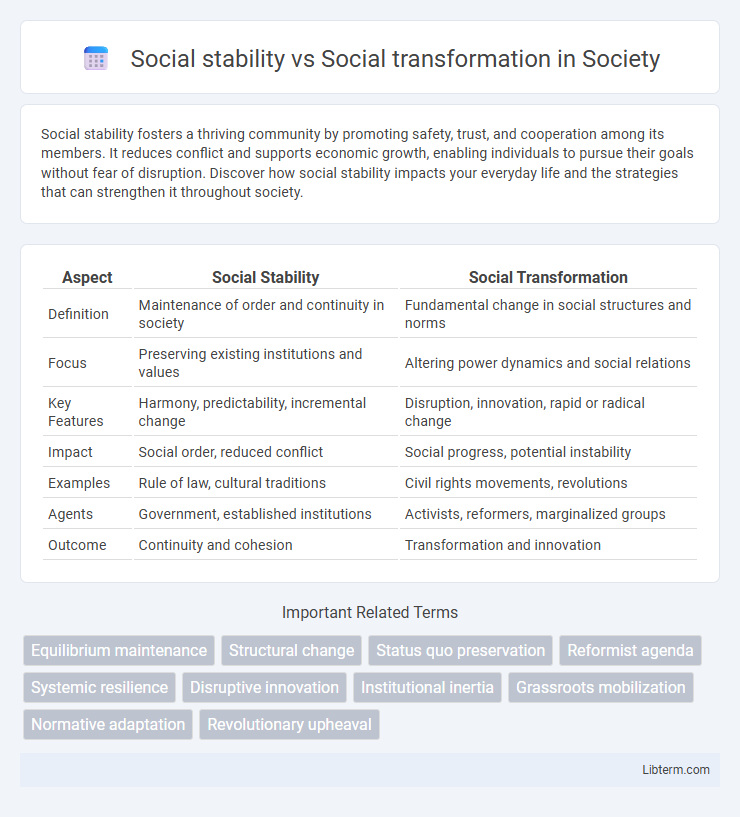Social stability fosters a thriving community by promoting safety, trust, and cooperation among its members. It reduces conflict and supports economic growth, enabling individuals to pursue their goals without fear of disruption. Discover how social stability impacts your everyday life and the strategies that can strengthen it throughout society.
Table of Comparison
| Aspect | Social Stability | Social Transformation |
|---|---|---|
| Definition | Maintenance of order and continuity in society | Fundamental change in social structures and norms |
| Focus | Preserving existing institutions and values | Altering power dynamics and social relations |
| Key Features | Harmony, predictability, incremental change | Disruption, innovation, rapid or radical change |
| Impact | Social order, reduced conflict | Social progress, potential instability |
| Examples | Rule of law, cultural traditions | Civil rights movements, revolutions |
| Agents | Government, established institutions | Activists, reformers, marginalized groups |
| Outcome | Continuity and cohesion | Transformation and innovation |
Understanding Social Stability: Definition and Significance
Social stability refers to the consistent and predictable functioning of societal institutions, ensuring order and harmony within communities. It plays a crucial role in maintaining public trust, preventing conflicts, and supporting sustainable economic development. Understanding social stability involves analyzing factors like social norms, governance, and collective behavior that contribute to a cohesive and resilient society.
What Drives Social Transformation? Key Factors
Social transformation is driven by key factors such as technological innovation, economic shifts, and evolving cultural values that challenge existing social structures and norms. Political movements and policy reforms also play crucial roles by addressing inequalities and redistributing power. These dynamic forces catalyze changes that reshape societal institutions and relationships, often creating tensions between the desire for social stability and the need for progress.
Historical Perspectives on Stability and Change
Historical perspectives on social stability emphasize the maintenance of established institutions, norms, and power structures that promote order and continuity within societies. Social transformation, conversely, involves significant shifts in cultural, political, or economic systems, often driven by revolutionary movements, technological innovations, or ideological changes. Analyzing events such as the Industrial Revolution and civil rights movements reveals how periods of stability coexist with transformative changes that redefine societal frameworks over time.
The Role of Institutions in Maintaining Stability
Institutions such as legal systems, governments, and educational bodies play a crucial role in maintaining social stability by enforcing norms, laws, and customs that uphold order and reduce conflict. These institutions provide continuity and predictability, enabling societies to function smoothly despite changes and external pressures. However, their adaptability or rigidity directly influences the potential for social transformation, either facilitating reform or resisting change to preserve the existing social order.
Agents and Catalysts of Social Transformation
Agents of social transformation such as activists, reformers, and marginalized groups challenge existing social stability by promoting new norms and values that drive systemic change. Catalysts of social transformation include technological innovations, economic shifts, and political movements that disrupt traditional power structures and enable rapid societal evolution. Social stability relies on established institutions and cultural continuity, while transformation depends on dynamic actors and forces that redefine social order.
Stability versus Transformation: Core Theoretical Debates
Social stability emphasizes the maintenance of established social structures and norms to ensure continuity and order within societies, often highlighting the importance of shared values and institutions. In contrast, social transformation advocates for fundamental changes in social relationships and power dynamics to address inequality and promote justice, driven by theories such as Marxism and critical social theory. Core theoretical debates center on whether gradual adaptation or radical overhaul best achieves societal progress, balancing the risks of disruption against the need for adaptation and reform.
Impact on Society: Benefits and Risks of Each Approach
Social stability fosters a predictable environment that supports economic growth, cultural continuity, and community cohesion, reducing risks of social unrest and fragmentation. Social transformation drives innovation, equality, and adaptation to changing global challenges, though it can provoke resistance, uncertainty, and potential instability during transitions. Balancing these approaches ensures sustainable progress by managing the benefits of continuity alongside the risks associated with profound social change.
Case Studies: Societies Favoring Stability or Transformation
Societies like Japan demonstrate a strong preference for social stability, emphasizing harmony, tradition, and incremental change to maintain social order and economic growth. In contrast, South Africa's post-apartheid transformation highlights a radical social shift aimed at dismantling systemic inequality and fostering inclusivity through policy reforms and grassroots activism. These case studies illustrate how cultural values and historical contexts drive the balance between preserving social structures and pursuing transformative change.
Balancing Social Stability with Necessary Transformation
Balancing social stability with necessary transformation requires maintaining order while promoting progressive change to address evolving societal needs. Effective policies should safeguard fundamental institutions and social cohesion, enabling adaptive reforms that respond to economic, cultural, and technological shifts. Strategic engagement of community stakeholders helps ensure that transformation enhances equity and resilience without triggering disruptive instability.
Future Outlook: Navigating Change in a Dynamic World
Social stability ensures continuity by maintaining established institutions and values, providing a foundation for cohesive communities amid rapid change. Social transformation drives innovation and adaptation, addressing systemic inequalities and emerging challenges through progressive reforms. Future outlooks emphasize balancing these forces to foster resilience, inclusive growth, and sustainable development in an increasingly interconnected and dynamic global society.
Social stability Infographic

 libterm.com
libterm.com